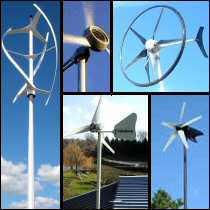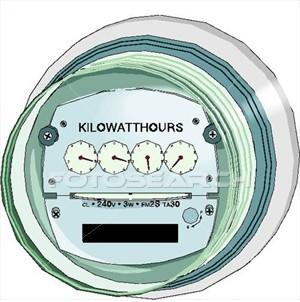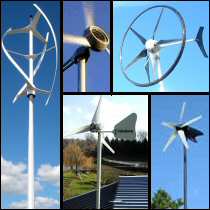How Much Green Electricity And Money Savings Can I Expect From A Wind Turbine?
This article provides you with detailed information about how much green electricity wind turbines can produce and the $ savings which can be achieved.
GENERAL WIND INFO:
As a thumb of rules, for every doubling in wind speed, the energy available from the wind increases approximately eightfold. Therefore, the more exposed your site is and the greater the average wind speed obtainable at your site, the greater the potential for harnessing power from the wind.
Furthermore, wind speed increases with height whilst at the same time turbulence reduces, providing a more reliable and consistent power output and a safer operating environment for the turbine.
ELECTRICITY GENERATION:
Well sited wind turbines can expect to produce energy equivalent to their rated power for around 30% of the year. Here a few examples based on this conversion rate:
A turbine rated at 4Kw: (4kW x 0.3 x 8760 hours in a year) = 10,512 kWh per year.
A turbine rated at 5Kw: (5kW x 0.3 x 8760 hours in a year) = 13,140 kWh per year.
A turbine rated at 10Kw: (10kW x 0.3 x 8760 hours in a year) = 26,280 kWh per year.
A turbine rated at 20Kw: (20kW x 0.3 x 8760 hours in a year) = 52,560 kWh per year.
If your site is exposed to the wind which produces a higher conversion rate to let’s say 40% or 50% of the year, then simply use the above formula and apply the equivalent denominator i.e multiply by 0.4 or 0.5 etc.
ELECTRICITY CONSUMPTION:
To give you an idea of the watt consumption of standard household electrical equipment, below is a table showing a few examples. You can always obtain the exact watt rate of any of your equipment used at home (fridge, dishwasher, tumble dryer etc.) from the technical label usually attached at the back of the equipment.
Medium unit Window AC 1000 Watts one hour 1kWh
Large unit Window AC 1500 Watts one hour 1.5kWh
Light Bulb 100 Watts 730 hours 73kWh
ELECTRICITY COSTS:
The average cost of residential electricity was 11¢/kWh in the U.S. in December 2008. The average US household uses approx. 936 kWh/mo. and would pay about $100 for it based on this average rate.
But to make sure to get your calculations right, please note that the cost of electricity depends very much on where you live, how much you use, and possibly when you use it. Prices can range from 7¢ in Idaho to 30¢ in Hawaii. There are also fixed charges that you pay every month no matter how much electricity you use. For example, it is not unusual that you have to pay $6/mo. for the privilege of being a customer of the electric company, no matter how much energy you use. Make sure that any additional standing charges are added to your calculation.
Check your utility bill for the rates in your area. If it’s not on your bill then look it up on the utility’s website. Another, more simple way to calculate your average cost per kWh would be to monitor your monthly bills over a six month period and add up the total $ amount of all bills (incl. standing charges, tax etc.) and divide by the total kWh used for the same period.
ELECTRICITY COST SAVINGS:
If all the above-calculated power is used to offset electricity costing an average of 11 cents per kWh, then a saving of $1,156 per year with a 4Kw turbine could be possible and $5,782 with a 20Kw turbine (xxx kWh per annum x $0.11).
This Windmax – 2Kw Wind Turbine below costs only $1,899 to purchase and can save you approx. $580 per annum in electricity costs. Your initial investment would be recouped in only just over 3 years and after this, your savings will start to accumulate very quickly. Imagine the things you can do with an extra $580 each year at hand? This is nearly $6,000 in 10 years.
Windmax 2Kw – $1,899
Please also note that in order to achieve any $ savings, you must ensure that your proposed site has average wind speeds of at least 5 metres per second, preferably 6m/s before installing a wind turbine. To find out about the average wind speed in your area, please check our On-Line Wind Finder guide which provides all the information you would need to establish the exact wind speeds in your area.








Try multiplying in a typical capacity factor. For commercial 0.35 is used. Residential will be lower than that. Then you begin to come closer to the actual power generated.
“A turbine rated at 4Kw: (4kW x 0.3 x 8760 hours in a year) = 10,512 kWh per year.” Now multiply by the optimistic 0.35 and you get 3,500 kWh per year.
Providing the quality is good enough for the turbine to operate.
The output of wind turbines not depend on the rated power, also depended on the wind speed and wind time of the area.
Even the same 10kw wind turbines, the diffrent height of tower will provide different output power.
Great info.
It maybe wise for potential buyers to invest in an electric metering device. I got one for christmas 2 years ago and it wirelessly gives energy usage for the entire house.
Although your electricity bill can tell you how much power you use, it can not say what your peak usage is. Real-time measurements can be an eye-opener.
Hello,
Let me know the price for installation of wind power and battery consumption to 7 kilowatt-hours and 14 kilowatt-hour.
I live in Cape Verde Islandsand this would be a departure from Boston.
Thank you for answering, greetings,
Didier Jeanne